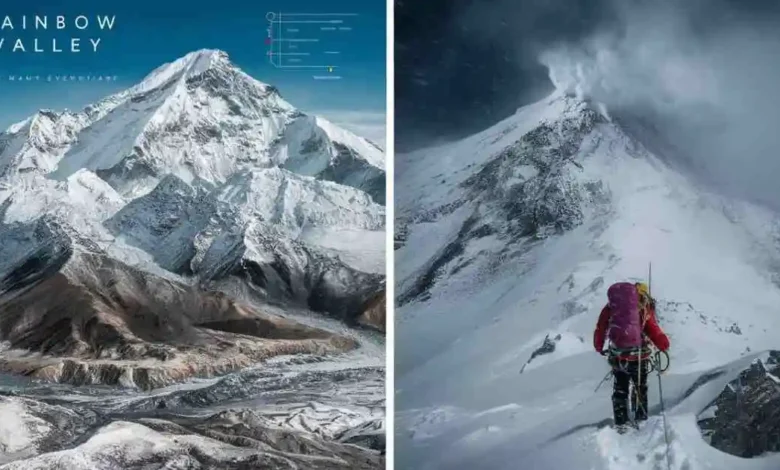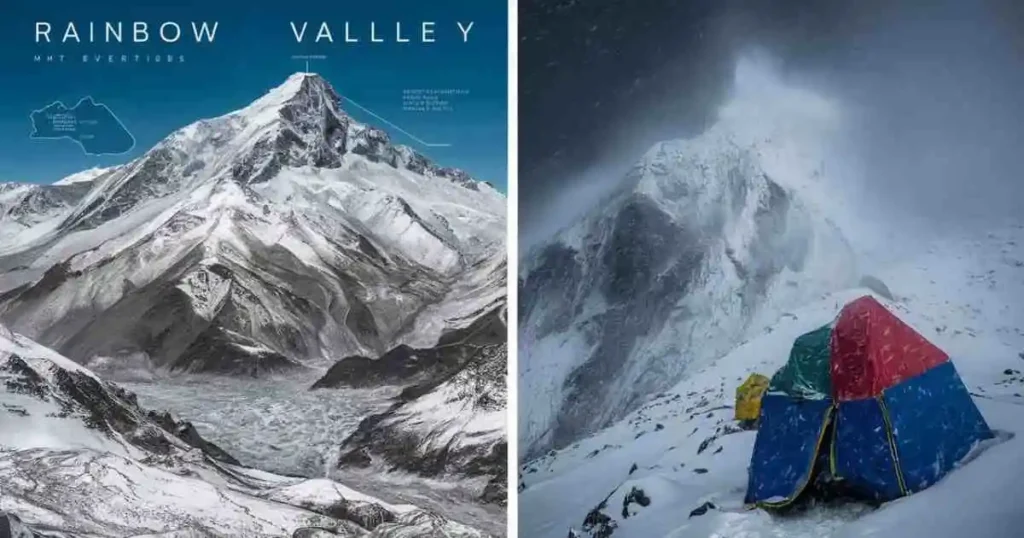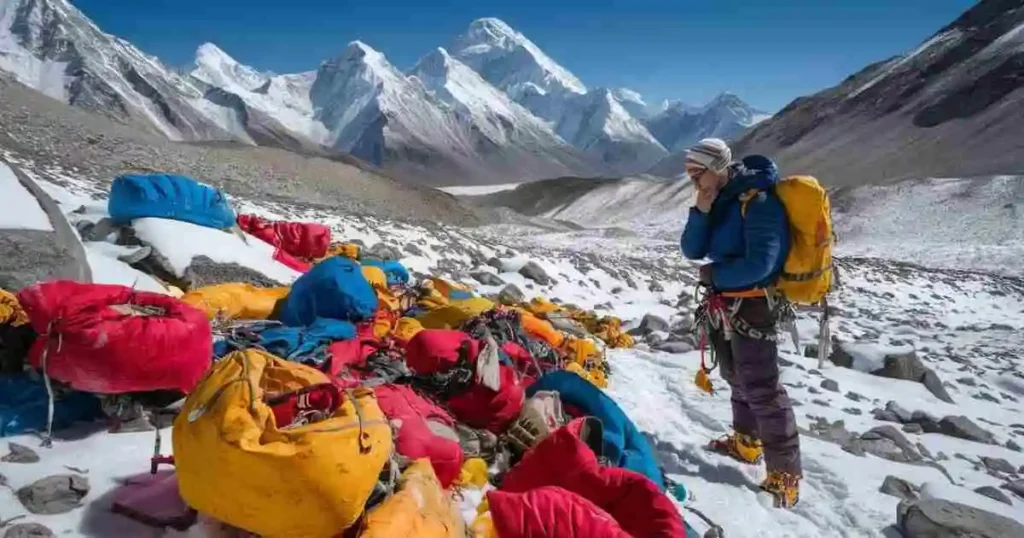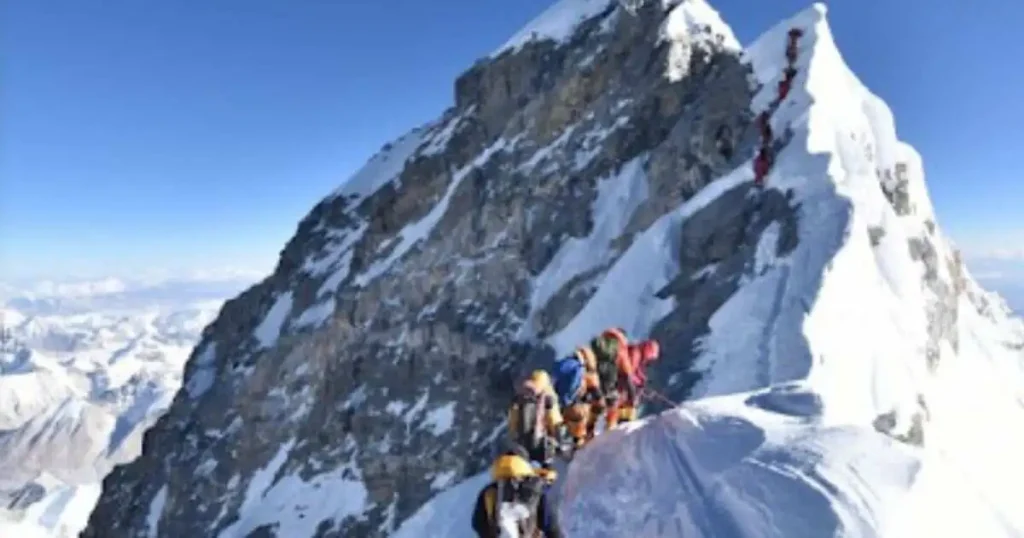Exploring Rainbow Valley Mt Everest: A Journey Beyond the Summit

If you’re an adventure enthusiast, nature lover, or avid hiker, the enigmatic Rainbow Valley mt Everest is a destination that will capture your imagination. Nestled high in the Himalayas, this area is as beautiful as it is poignant. This guide will help you understand the allure and significance of Rainbow Valley and provide you with the necessary tips and information to plan your own expedition to this awe-inspiring location.
What is Rainbow Valley Mt Everest?
Rainbow Valley Mt Everest, is a mysterious and intriguing location high on the world’s tallest mountain. Situated near the summit at an altitude of around 8,500 meters (27,887 feet), this area is notorious among climbers for its beauty and danger. The name “Rainbow Valley” comes from the colorful jackets and gear left behind by climbers who never made it back. These bright colors stand out against the stark white snow, creating a hauntingly beautiful sight. Rainbow Valley is not just a place on a map; it is a somber reminder of the challenges and risks that climbers face on their journey to the top of the world.
The Allure of Rainbow Valley
Despite its tragic connotations, Rainbow Valley holds a unique allure for many climbers and adventurers. Here are a few reasons why:
1. Historical Significance
Rainbow Valley stands as a testament to the courage and determination of climbers who dared to conquer Everest. Each piece of brightly colored clothing tells a story of ambition and bravery, making it a site of historical importance in the mountaineering community.
2. Natural Beauty
The juxtaposition of vibrant colors against the icy backdrop of Everest is mesmerizing. For nature lovers, the surreal beauty of Rainbow Valley offers a unique and poignant perspective on the mountain’s harsh environment.
3. Personal Challenge
For many hikers and climbers, reaching Rainbow Valley represents a significant personal achievement. It’s a milestone on the way to conquering Everest, symbolizing the triumph of human spirit over extreme adversity.
The Geography of Rainbow Valley Mt Everest
Location and Altitude
Rainbow Valley is located on the northern side of Mt Everest, close to the summit. Its high altitude and treacherous terrain make it one of the most challenging parts of the climb. At such heights, the air is thin, and oxygen levels are dangerously low, making every step a struggle. The location of Rainbow Valley Mt Everest adds to its mystique, as climbers must navigate steep, icy slopes to reach it. The valley serves as a critical point on the journey to the summit, marking both progress and peril.
The Climatic Conditions
The climatic conditions in Rainbow Valley Mt Everest, are extreme and unpredictable. Temperatures can plummet to well below freezing, and fierce winds whip across the mountain, making it difficult for climbers to stay on course. Snowstorms and avalanches are common threats that can strike without warning. These harsh conditions demand the utmost preparation and caution from climbers, as any misstep can have serious consequences. Understanding the climate is crucial for anyone attempting to navigate this formidable part of the mountain.
The Tragic Reality of Rainbow Valley Mt Everest

Why the Name “Rainbow Valley”?
The name “Rainbow Valley” carries a poignant meaning. It refers to the many colorful jackets, ropes, and gear left behind by climbers who perished in this part of the mountain. These items create a vivid array of colors that stand out against the white snow and ice. While the sight might be visually striking, it serves as a solemn reminder of the lives lost in pursuit of a dream. Rainbow Valley, Mt Everest, is not just a place of beauty; it is a testament to the mountain’s unforgiving nature and the challenges climbers face.
The Dangers of Climbing Mt Everest
Climbing Mt Everest is fraught with danger, and the area around Rainbow Valley is no exception. The lack of oxygen at high altitudes can lead to altitude sickness, which impairs judgment and physical ability. The steep, icy terrain requires careful navigation, as a single misstep can be fatal. Frostbite and hypothermia are constant threats in the freezing temperatures. Additionally, the physical and mental exhaustion that climbers experience at such altitudes can lead to deadly mistakes. Those who venture into Rainbow Valley Mt Everest, must be prepared for these challenges and respect the mountain’s power.
The History of Rainbow Valley Mt Everest

Early Expeditions
Rainbow Valley, Mt Everest, has a rich history dating back to the earliest expeditions to the mountain. As climbers explored the daunting slopes of Everest, they encountered the valley and its unique challenges. Early expeditions lacked the advanced gear and technology available today, making their journeys even more perilous. Despite the risks, these pioneers documented their experiences, paving the way for future climbers. Their stories of perseverance and bravery continue to inspire those who follow in their footsteps.
Famous Climbers and Their Stories
Many famous climbers have encountered Rainbow Valley Mt Everest, leaving behind stories that resonate with the climbing community. For example, the 1996 Everest disaster, which claimed the lives of several climbers, brought global attention to the dangers of the mountain. The stories of climbers like Rob Hall and Doug Hansen highlight the risks and decisions that can mean the difference between life and death. These tales serve as a reminder of the mountain’s power and the importance of preparation and respect.
ALSO READA ABOUT HIGHER EDUCATION LOAN AUTHORITY OF THE STATE OF MISSOURI NEWS
Modern Climbing and Rainbow Valley Mt Everest
Safety Measures for Climbers
Today, climbers have access to advanced safety measures that can help them navigate the challenges of Rainbow Valley Mt Everest. Experienced guides and Sherpas provide invaluable support, offering expertise and knowledge of the mountain. Climbers are encouraged to plan their expeditions carefully, taking into account weather conditions and potential risks. Following established routes and using modern equipment can increase the chances of a successful and safe climb. Above all, climbers must listen to their bodies and prioritize safety over ambition.
Technological Advances in Climbing
Technological advances have transformed the climbing experience on Mt Everest, including in Rainbow Valley. Lightweight clothing, advanced oxygen systems, and improved climbing gear have made it easier for climbers to endure the harsh conditions. Communication devices allow climbers to stay in contact with their teams and receive real-time updates on weather and route conditions. These advances have improved the odds of reaching the summit and returning safely, although the mountain remains a formidable challenge.
Preparing for the Journey

Visiting Rainbow Valley requires meticulous planning and preparation. Here’s a step-by-step guide to help you get ready for this extraordinary adventure:
Step 1: Research and Understand the Risks
Before embarking on your journey, it’s crucial to understand the inherent risks of climbing Mount Everest. The extreme altitude, severe weather conditions, and difficult terrain make it one of the most challenging climbs in the world. Familiarize yourself with the potential hazards and ensure you are fully prepared both mentally and physically.
Step 2: Physical Conditioning
Climbing Everest is a demanding physical endeavor that requires excellent fitness levels. Start preparing at least a year in advance with a rigorous training regimen that includes cardiovascular exercises, strength training, and endurance workouts. Focus on building stamina, core strength, and the ability to carry heavy loads over long distances.
Step 3: Acclimatization
Acclimatization is essential to prevent altitude sickness. Plan multiple acclimatization stops during your ascent to allow your body to adjust to the decreasing oxygen levels. These stops are crucial for your safety and will improve your chances of reaching Rainbow Valley and beyond.
Step 4: Gear and Equipment
Invest in high-quality gear and equipment suitable for extreme weather conditions. Essential items include:
- Insulated mountaineering boots
- Thermal clothing layers
- High-altitude sleeping bags
- Climbing harness and ropes
- Ice axe and crampons
- Oxygen cylinders and masks
- First aid kit and medications
Ensure that all your equipment is tested and in excellent condition before the climb.
Step 5: Hiring a Guide
Consider hiring an experienced guide or joining an organized expedition. Professional guides offer invaluable knowledge of the terrain, weather patterns, and best practices for safe climbing. They can also provide essential support and assistance throughout your journey.
The Climb to Rainbow Valley
The trek to Rainbow Valley is part of the greater expedition to the summit of Mount Everest. Here’s a breakdown of the key stages of the climb:
Base Camp to Camp 1
The journey begins at Everest Base Camp (EBC), situated at 17,600 feet. From EBC, you’ll make your way through the perilous Khumbu Icefall, a constantly shifting glacier with deep crevasses and towering ice seracs. This section is one of the most dangerous parts of the climb and requires careful navigation and the use of ladders and ropes.
Camp 1 to Camp 2
After crossing the Khumbu Icefall, you’ll reach Camp 1, located at 19,500 feet. From here, the route follows the Western Cwm, a relatively flat glacial valley surrounded by towering peaks. The trek to Camp 2 (21,300 feet) is less technical but still challenging due to the altitude and intense solar radiation.
Camp 2 to Camp 3
The ascent from Camp 2 to Camp 3 (23,500 feet) involves climbing the Lhotse Face, a steep wall of ice and snow. This section requires the use of fixed ropes and careful placement of crampons and ice axes. The Lhotse Face is physically demanding and exposes climbers to the harsh elements of the mountain.
Camp 3 to Camp 4
From Camp 3, you’ll continue your ascent to Camp 4, also known as the “Death Zone” (26,000 feet). The Death Zone is characterized by extremely low oxygen levels and harsh conditions that make it difficult for the human body to function. Climbers must move quickly and efficiently to minimize time spent in this dangerous environment.
Camp 4 to Rainbow Valley
The final push from Camp 4 to Rainbow Valley requires immense mental and physical fortitude. As you ascend, you’ll pass through the South Col and traverse the Southeast Ridge. The path is narrow and exposed, with sheer drops on either side. Rainbow Valley lies just below the summit, at approximately 28,000 feet. Reaching this point is a remarkable achievement and a testament to your determination and skill.
ALSO READA ABOUT HIGHER EDUCATION LOAN AUTHORITY OF THE STATE OF MISSOURI NEWS
The Final Push to the Summit
Beyond Rainbow Valley lies the ultimate goal: the summit of Mount Everest. The final push involves traversing the treacherous Hillary Step, a near-vertical rock face that presents a significant obstacle. Once you conquer the Hillary Step, it’s a short but challenging climb to the summit at 29,032 feet.
Reaching the summit is a momentous achievement, a testament to your determination, perseverance, and respect for the mountain. Take in the breathtaking views from the top of the world and savor the sense of accomplishment that comes with conquering Everest.
Embracing the Spirit of Adventure
The journey to Rainbow Valley and the summit of Mount Everest is not just a physical challenge but a transformative experience. It tests your limits, pushes you to new heights, and rewards you with unparalleled beauty and insight. Embrace the spirit of adventure, respect the mountain, and cherish the memories of this extraordinary journey.
Key Takeaways
- Respect the Mountain: Mount Everest demands respect and preparation. Approach the climb with humility and caution.
- Safety First: Prioritize safety at all times and be prepared to turn back if conditions become too dangerous.
- Honor the Fallen: Remember the climbers who came before you and honor their memory by climbing responsibly and ethically.
- Enjoy the Journey: The climb to Rainbow Valley is an adventure of a lifetime. Savor every moment and appreciate the beauty of the Himalayas.
In the end, the journey to Rainbow Valley and Mount Everest is about more than reaching the summit. It’s about embracing the challenges, finding strength within yourself, and celebrating the incredible world we live in.
Final Thoughts for Rainbow Valley Mt Everest
In conclusion, Rainbow Valley Mt Everest, is a place of mystery and reverence, where the stories of courage and tragedy are intertwined. The experiences of those who have ventured into this region teach us valuable lessons about determination, preparation, and respect. For those who dream of climbing Everest, it is essential to prioritize safety and honor the mountain’s history. As we reflect on the significance of Rainbow Valley, let us be inspired by the spirit of adventure and the quest for exploration while remembering the importance of responsibility and respect.
FAQ: Rainbow Valley Mt Everest
What is the main cause of death on Mount Everest?
The main causes of death on Mount Everest are altitude sickness, exhaustion, hypothermia, and avalanches. Altitude sickness, or acute mountain sickness (AMS), occurs due to the low oxygen levels at high altitudes, which can lead to severe health complications and even death.
What happens to the dead bodies on Mount Everest?
The dead bodies on Mount Everest often remain on the mountain due to the extreme conditions and difficulty of retrieval. Many bodies are preserved by the freezing temperatures and act as markers for climbers. Recovery operations are risky and costly, which contributes to the bodies remaining where they fall.
Where is the death zone of Mt Everest?
The “death zone” on Mt. Everest is above 8,000 meters (26,247 feet). In this area, the oxygen level is insufficient to sustain human life for an extended period, making it extremely challenging and dangerous for climbers.
Why are the dead bodies piling up in Rainbow Valley, Everest?
The dead bodies pile up in Rainbow Valley because it is located in the high-altitude death zone, where climbers are exposed to extreme conditions. Recovering bodies from this area is challenging due to the harsh environment, steep terrain, and the risk to living climbers. As a result, the bodies often remain where they fall.
Where can I find Rainbow Valley Mt Everest pictures on Reddit?
You can find pictures of Rainbow Valley on Reddit by searching through subreddits related to mountaineering, Everest expeditions, or climbing communities. Subreddits like r/Everest or r/Climbing may have relevant images and discussions.
Where can I find Rainbow Valley Mt Everest pictures on YouTube?
Rainbow Valley pictures and videos can be found on YouTube by searching for terms like “Rainbow Valley Mt Everest” or “Everest Rainbow Valley”. There are several climbing documentaries and vlogs that feature visuals of this area.
Where can I find Rainbow Valley Mt Everest pictures of bodies?
Pictures of bodies in Rainbow Valley are often shared in discussions about the mountain’s dangers and are sometimes included in documentaries. For such specific content, search through climbing-focused forums, documentaries, or news coverage related to Everest.
Where can I find Rainbow Valley Mt Everest pictures related to deaths?
Images related to deaths in Rainbow Valley can be found in detailed mountaineering documentaries, news reports, and climbing forums. These images are often used to highlight the risks associated with Everest climbing.
What is “Sleeping Beauty” on Mount Everest?
“Sleeping Beauty” is the nickname given to one of the prominent bodies found in Rainbow Valley. The body’s position and attire make it a recognizable and tragic landmark for climbers.







